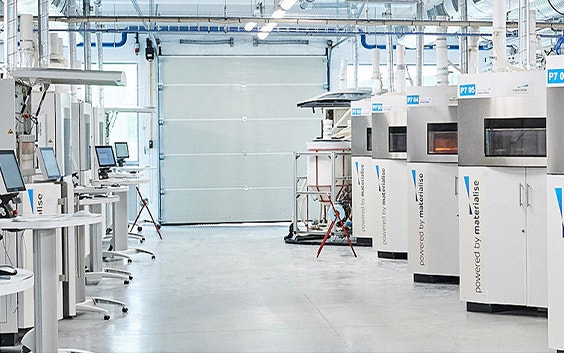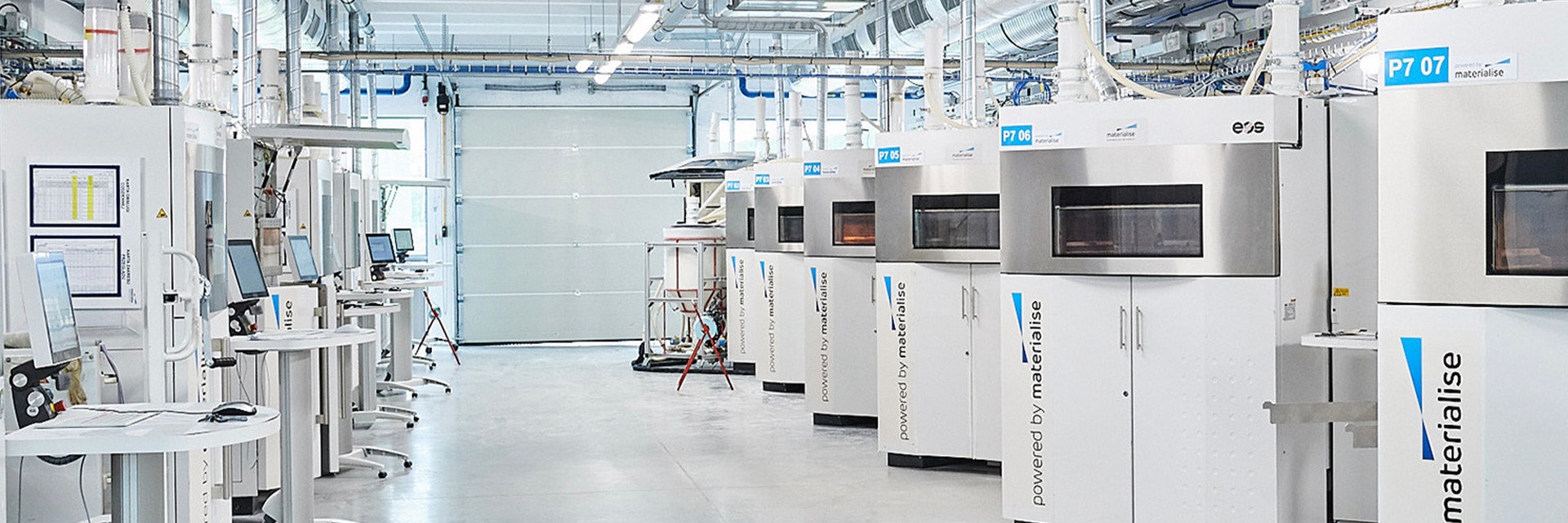EXPERT INSIGHT
The Future Is…a Smart Factory

30 years in the making, 3D printing is no longer just a prototyping technology. The development of smart production systems has caused a fundamental change in manufacturing, with systems that now allow for more flexible, automated operations and cost-effective manufacturing of end-use consumer products.
Smart manufacturing is a giant, not-so-secret trend estimated to triple in the coming years. Zion Market Research projects revenue in the smart manufacturing market to reach USD 479 billion by 2023. The rising demand for personalized products means series production batches are getting smaller, and customers are always looking for the next best model. A faster succession of products is therefore essential to success.
In line with these shifts and to combat the trade-off of the more complex production processes that come with customization, Materialise has focused on developing solutions that support smart manufacturing by design, from initial scan all the way through post-production. In 2019, these efforts were rewarded as we were recognized as a Factory of the Future by industry platforms Agoria and Sirris.
Manufacturing as an ecosystem
At Materialise, we are always trying to push the 3D printing process further. Our vast team of software developers is focused on developing new software capabilities to help create a sophisticated ecosystem that allows for traceability and live feedback over the complete production process.
Essential to being a smart factory is having the capability and tools to make smart decisions from the outset. All of our builds at Materialise are hooked up to our Materialise Manufacturing Execution System (MES), which acts as a central backbone connecting all of the digital systems in the workflow and allows us to make optimal use of the machines we have available. Our Materialise Magics software helps in data preparation, ensuring the files and resulting parts are optimized for printing, and then this data is sent to the Materialise Build Processor, which translates it into data that the machine can understand about how the part should be built.
But a true ecosystem is not complete without feedback between all of the working parts. Enter the Materialise Control Platform. The Control Platform is a hardware solution that is placed directly inside your machine. As a print progresses, the Control Platform speaks directly with other components, such as the laser scanner or cameras, and turns this data into live feedback and guidance on how to improve any problems with the build.
This level of robust process control means that decisions can be made immediately on issues like whether problem parts should be scrapped or if a machine needs urgent maintenance to maintain control over the build. But it also allows for the development of all sorts of new applications based on the needs of specific materials or builds.
The key to success in smart manufacturing is always thinking about the future. That is why Materialise’s R&D team focuses on understanding and researching additive manufacturing processes. As Tom Craeghs, our Research Project Manager, describes, “The problems I’m targeting with my group are not the day-to-day issues that one might encounter in the manufacturing environment, but we really try to see, from the in-depth expertise that is available in my group, how can we make improvements that will be necessary in one or two years.”
Smart decisions by design
Deformations, residual stresses, and temperature fluxes can often lead to production failures. At Materialise, we want to reduce these problems by anticipating them in advance and are embracing tools like simulation to improve print planning from the start. With simulation, you can identify and correct regions sensitive to failure, increasing your chance of a successful build, as well as improving overall part quality.
Going into a build, a lot of decisions need to be made — the type of material, what printing process to use, the ideal part orientation, and what support structures are needed. These decisions need to be functional and cost-effective and traditionally could often only be answered by doing a test build to determine the optimal setup. But test builds can take a lot of time and money and, in some cases, don’t always provide full physical insight into what’s happening during the print.


“That’s why we have really pushed simulation,” Craeghs explains. “Because you can do all of these things virtually and really see how the part is going to be built. Users can make a lot of intelligent decisions without the need to do a single print. Simulation is really key in a smart factory to take difficult decisions without the need for a lot of experimental work.”
Getting our hands dirty in design
World-class manufacturing technologies are essential to the well-functioning modern factory, but to be truly smart, a factory also needs to get its hands dirty and embrace collaboration.
Customers can’t get enthusiastic about a product until they see its capabilities using real-world examples. At Materialise, all of our software products and solutions are also used in our in-house manufacturing, which allows us to harvest these experiences and apply what we’ve learned to improve the products and services we offer our customers.
Tom elaborates: “What makes our company very strong and smart is that we bring software to the market for 3D printing companies, but all the developments, all the new things that are in there, are very well validated and thought of by ourselves because we also internally print and manufacture. If we find something that could really enhance our production, for instance, we develop a new software algorithm that makes a certain type of print 10% faster, we also try to put that algorithm into our Magics or Build Processor software.”
This close collaboration between our departments and our customers means we can develop a full understanding of specific application needs. And by knowing where previous projects worked and failed, we can use this knowledge to push technology forward into new domains.
Mass customization
Since one of the main benefits of 3D printing is to have true freedom in design, Materialise is focused on developing solutions that support flexible automation of operations and processes. We’re constantly looking for new ways to incorporate personalization and complexity without being prohibited by exorbitant costs or an unreasonable time-to-market.
3D printing is an ideal technology to create unique, customized pieces on-demand, but the challenge comes in how to build these pieces at scale. Take, for instance, creating the world’s first 3D-tailored eyewear.


In a truly ground-breaking partnership, Materialise and HOYA developed Yuniku — a digital platform that allows eye care professionals the ability to offer their customers fully customized frames, designed to their face shape and constructed around the lens. Whereas traditionally, users would look for a frame that would best fit their face shape and ideal lens angle, now opticians can start from the best lens placement and design a truly tailored frame. A facial scan can give the exact measurements for the size of the bridge, temples, and more, and has reversed the way the industry has worked for centuries.
Using Materialise’s smart software solutions, complex mass customization projects such as Yuniku can finally be made possible. Tools like simulation and real-time feedback allow us to define the boundaries for successful variations, giving life to unique pieces quickly and cost-effectively. In a smart factory, our goal is that the only limit to what you can build is what you can dream.
Share on:
You might also like
Never miss a story like this. Get curated content delivered straight to your inbox.
